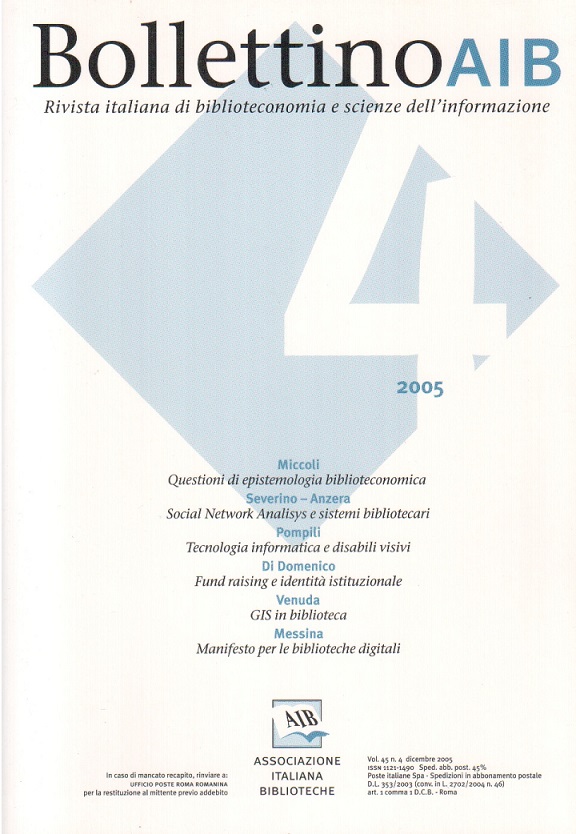Accessibility and integration: technological informatics at the service of the visually impaired for access to culture and information
Main Article Content
Abstract
At the moment technological informatics provides the visually impaired with a series of sophisticated hardware tools and software programmes that assists them in interacting with computers. Current informatic aids available to the visually impaired still have some problems and precise limits which are explained. The so-called “informatic barriers” still prevent the visually impaired from access to currently available information sources, especially Internet sites.
The article provides a description of the main informatic aids for the visually impaired. These include the screen reader, or screen analyzers. The latter are special software programmes that read and interpret the contents of the computer screen, making them usable to the user through voice synthesis (an informatic aid that memorizes the main phonetic sounds of the languages used and that, linked to the computer, transforms into the spoken word the letters and numbers that the computer visualizes on the monitor) or through the Braille stroke or bar (an informatic technique composed of a line of Braille cells of variable lengths, that makes it possible to transform the contents of a line of the monitor into a raised Braille text).
With the connection between Braille language and informatics defined, the essay passes to pointing out the differences between accessibility of an operations system with alphanumeric interface, such as the relatively simple MS DOS, with commands and reply messages formed of words and numbers (which easily lend themselves to being presented in a sound version with a synthetic voice or a touch version in a Braille row), with respect to the difficulties of a graphic interface (Windows) where each object must be interpreted and presented with a word or phrase of text that provides equivalent information.
Lastly, the theme of accessibility of web pages by the visually impaired is discussed. Reference is made to the Web Accessibility Initiative project and to the publication of Web Content Accessibility Guidelines 1.0. This consists of fourteen guidelines that indicate to authors of Web pages how to attempt to overcome the various obstacles of a technical nature that complicate the use of the net.
The article provides a description of the main informatic aids for the visually impaired. These include the screen reader, or screen analyzers. The latter are special software programmes that read and interpret the contents of the computer screen, making them usable to the user through voice synthesis (an informatic aid that memorizes the main phonetic sounds of the languages used and that, linked to the computer, transforms into the spoken word the letters and numbers that the computer visualizes on the monitor) or through the Braille stroke or bar (an informatic technique composed of a line of Braille cells of variable lengths, that makes it possible to transform the contents of a line of the monitor into a raised Braille text).
With the connection between Braille language and informatics defined, the essay passes to pointing out the differences between accessibility of an operations system with alphanumeric interface, such as the relatively simple MS DOS, with commands and reply messages formed of words and numbers (which easily lend themselves to being presented in a sound version with a synthetic voice or a touch version in a Braille row), with respect to the difficulties of a graphic interface (Windows) where each object must be interpreted and presented with a word or phrase of text that provides equivalent information.
Lastly, the theme of accessibility of web pages by the visually impaired is discussed. Reference is made to the Web Accessibility Initiative project and to the publication of Web Content Accessibility Guidelines 1.0. This consists of fourteen guidelines that indicate to authors of Web pages how to attempt to overcome the various obstacles of a technical nature that complicate the use of the net.
Article Details
Section
Articles

This work is licensed under a Creative Commons Attribution-ShareAlike 4.0 International License.
